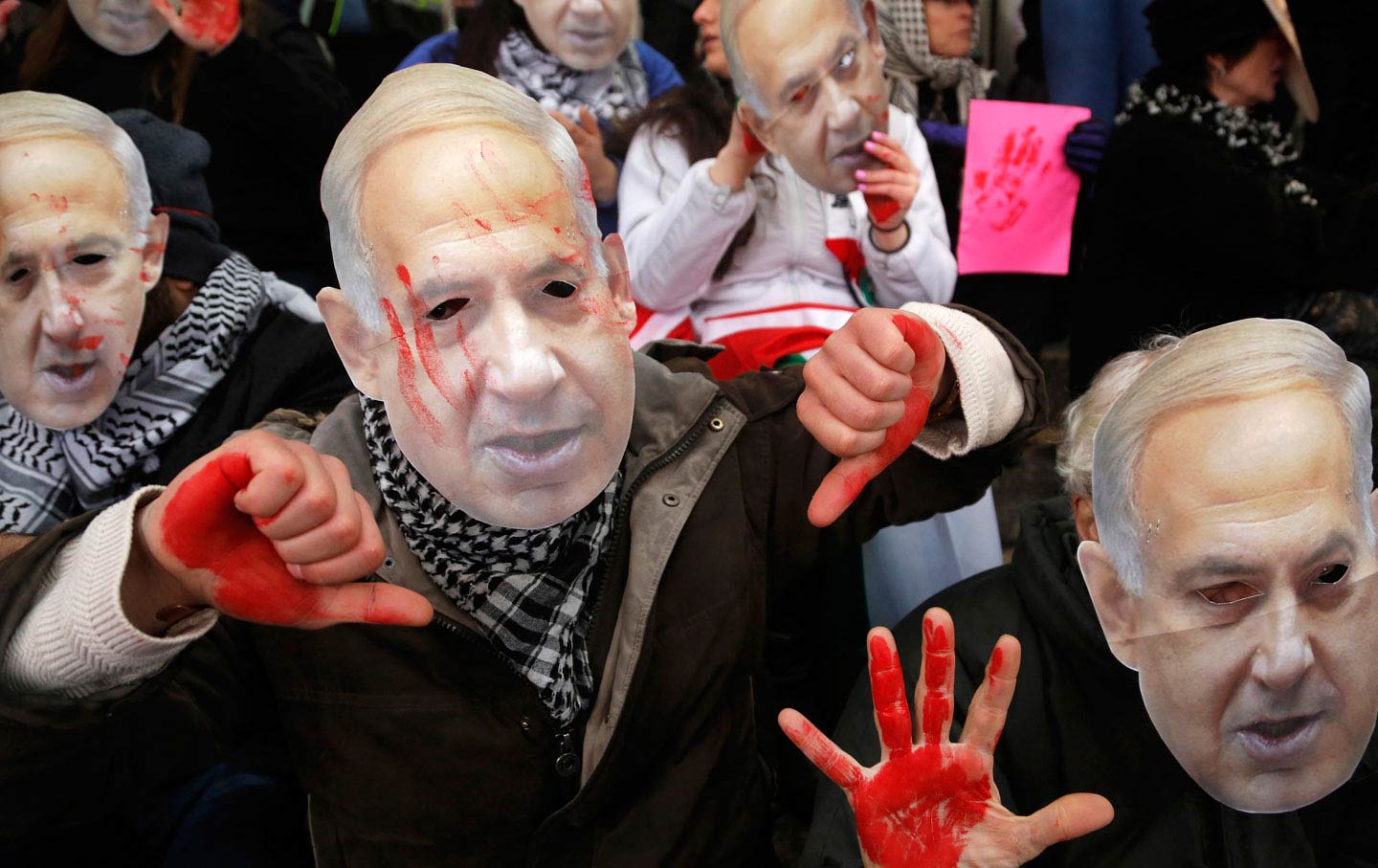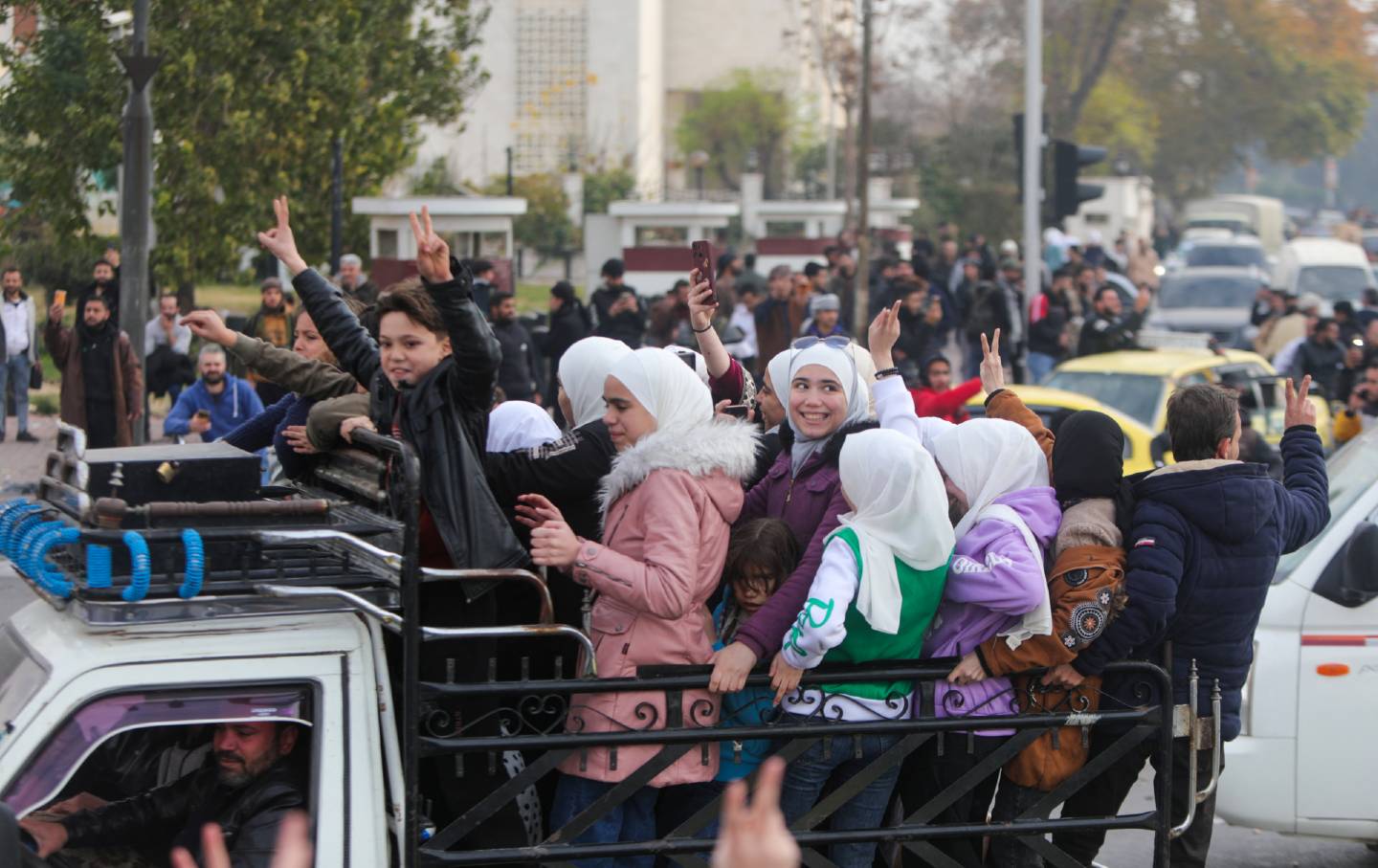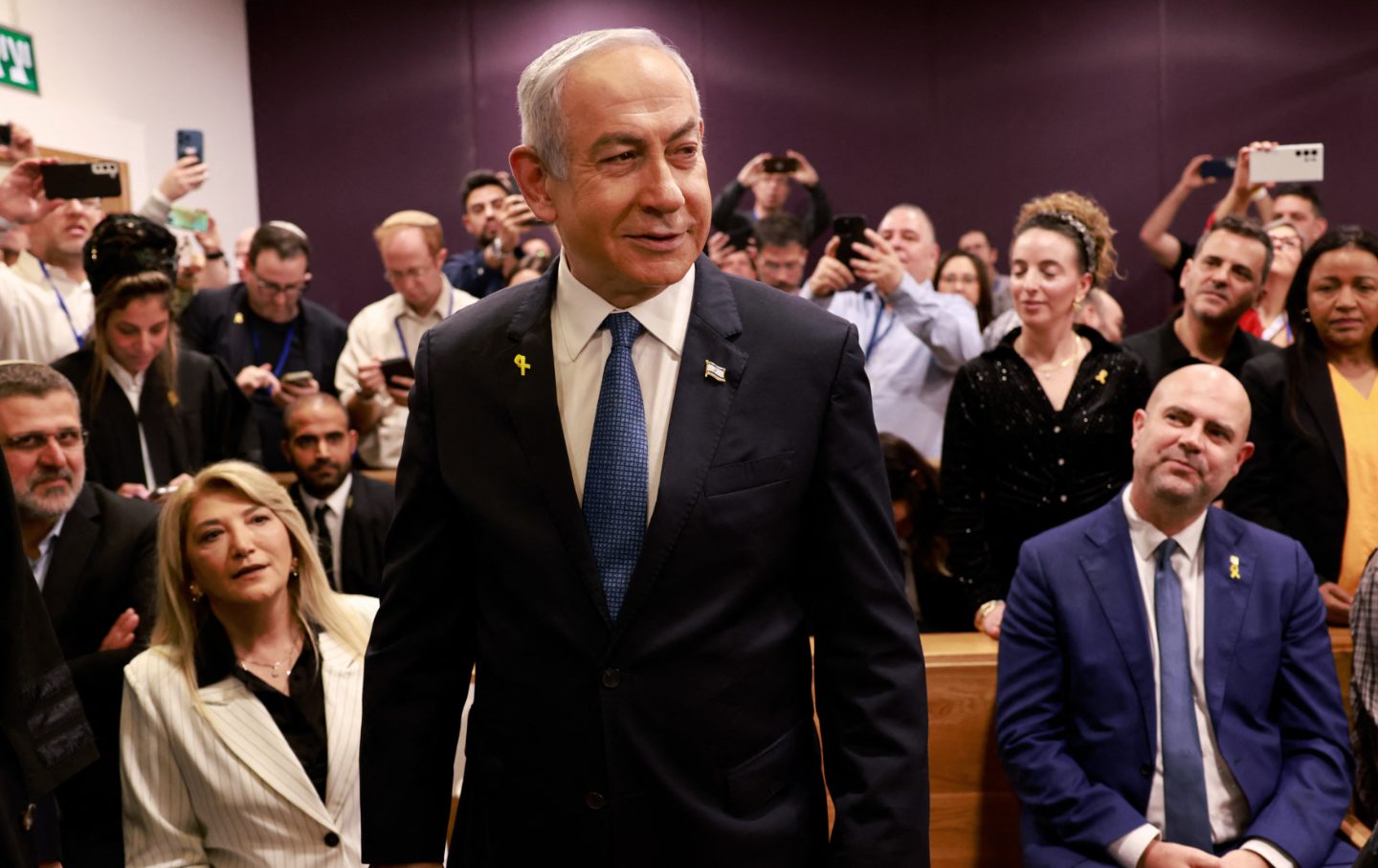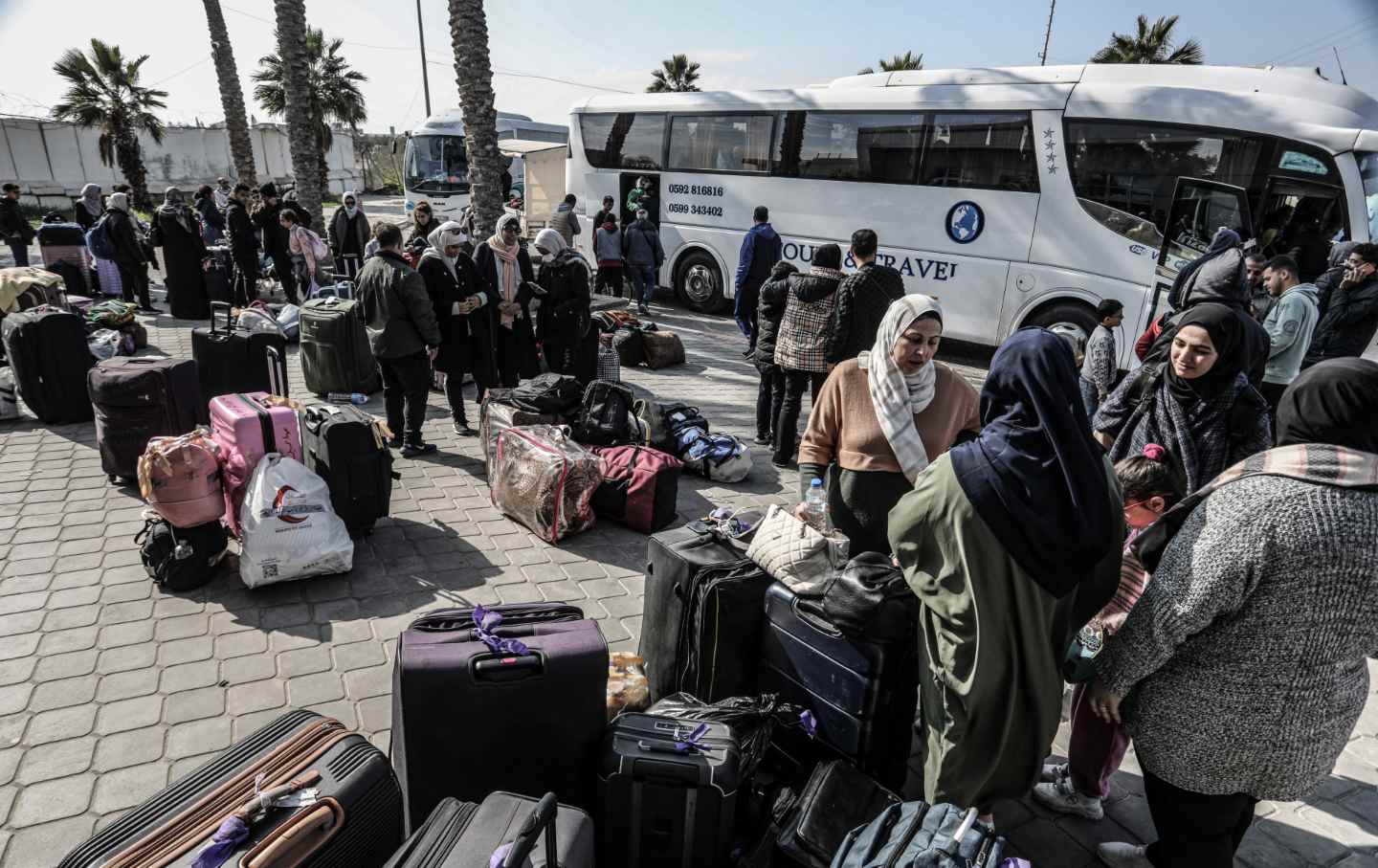The Looming Threat of Israel’s Nuclear Option
A cornered, nuclear-armed Benjamin Netanyahu would be the definition of a perilous situation in a war where nothing—not journalists, schools, or even hospitals—has proven off-limits.

This article originally appeared at TomDispatch.com. To stay on top of important articles like these, sign up to receive the latest updates from TomDispatch.com.
Israel’s robust military, the fourth-strongest in the world, is ravaging Gaza and, along with armed settlers, terrorizing Palestinians in the West Bank following the brutal Hamas massacres of October 7. Like so many other colonial projects, Israel was born of terror and has necessitated the use of violence to occupy Arab territory and segregate Palestinians ever since. The realization that its existence was dependent on a superior military in an unfriendly region also encouraged Israel to pursue a nuclear weapons program shortly after the state’s founding in 1948.
Even though Israel was a young nation, by the mid-1950s, with the aid of France, it had secretly begun the construction of a large nuclear reactor. That two allies had teamed up to launch a nuclear weapons program without the knowledge of the administration of President Dwight D. Eisenhower turned out to be a colossal (and embarrassing) American intelligence failure.
Not until June 1960, the final year of Eisenhower’s presidency, did US officials catch wind of what was already known as the Dimona project. Daniel Kimhi, an Israeli oil magnate, having undoubtedly had one too many cocktails at a late-night party at the US embassy in Tel Aviv, confessed to American diplomats that Israel was indeed constructing a large “power reactor” in the Negev desert—a startling revelation.
“This project has been described to [Kimhi] as a gas-cooled power reactor capable of producing approximately 60 megawatts of electric power,” read an embassy dispatch addressed to the State Department in August 1960. “[Kimhi] said he thought work had been underway for about two years and that a completion date was still about two years off.”
The Dimona reactor wasn’t, however, being built to deal with the country’s growing energy needs. As the United States would later discover, it was designed (with input from the French) to produce plutonium for a budding Israeli nuclear weapons program. In December 1960, as American officials grew more worried about the very idea of Israel’s nuclear aspirations, French Foreign Minister Maurice Couve de Murville admitted to US Secretary of State Christian Herter that France had, in fact, helped Israel get the project off the ground and would also provide the raw materials like uranium the reactor needed. As a result, it would get a share of any plutonium Dimona produced.
Israeli and French officials assured Eisenhower that Dimona was being built solely for peaceful purposes. Trying to further deflect attention, Israeli officials put forward several cover stories to back up that claim, asserting Dimona would become anything from a textile plant to a meteorological installation—anything but a nuclear reactor capable of producing weapons-grade plutonium.
Atomic Denials
In December 1960, after being tipped off by a British nuclear scientist concerned that Israel was constructing a dirty (that is, extremely radioactive) nuke, reporter Chapman Pincher wrote in London’s Daily Express: “British and American intelligence authorities believe that the Israelis are well on the way to building their first experimental nuclear bomb.”
Israeli officials issued a terse dispatch from their London embassy: “Israel is not building an atom bomb and has no intention of doing so.”
With Arab countries increasingly worried that Washington was aiding Israel’s nuclear endeavors, chairman of the Atomic Energy Commission John McCone leaked a classified CIA document to John Finney of The New York Times, claiming that the US had evidence Israel, with the help of France, was building a nuclear reactor—proof that Washington was none too pleased with that country’s nuclear aspirations.
President Eisenhower was stunned. Not only had his administration been left in the dark, but his officials feared a future nuclear-armed Israel would only further destabilize an already topsy-turvy region. “Reports from Arab countries confirm [the] gravity with which many view this possibility [of nuclear weapons in Israel],” read a State Department telegram sent to its Paris embassy in January 1961.
As that nuclear project began to make waves in the press, Israeli Prime Minister David Ben-Gurion moved quickly to downplay the disclosure. He gave a speech to the Knesset, the Israeli parliament, admitting the country was developing a nuclear program. “The reports in the media are false,” he added. “The research reactor we are now building in the Negev is being constructed under the direction of Israeli experts and is designed for peaceful purposes. When it’s complete, it will be open to scientists from other countries.”
He was, of course, lying and the Americans knew it. There was nothing peaceful about it. Worse yet, there was a growing consensus among America’s allies that Eisenhower had been in on the ruse and that his administration had provided the know-how to get the program off the ground. It hadn’t, but American officials were now eager to prevent United Nations inspections of Dimona, fearful of what they might uncover.
Popular
“swipe left below to view more authors”Swipe →By May 1961, with John F. Kennedy in the White House, things were changing. JFK even dispatched two Atomic Energy Commission scientists to inspect the Dimona site. Though he came to believe much of the Israeli hype, the experts pointed out that the plant’s reactor could potentially produce plutonium “suitable for weapons.” The Central Intelligence Agency, less assured by Israel’s claims, wrote in a now-declassified National Intelligence Estimate that the reactor’s construction indicated “Israel may have decided to undertake a nuclear weapons program. At a minimum, we believe it has decided to develop its nuclear facilities in such a way as to put it into a position to develop nuclear weapons promptly should it decide to do so.”
And, of course, that’s precisely what happened. In January 1967, NBC News confirmed that Israel was on the verge of a nuclear capability. By then, American officials knew it was close to developing a nuke and that Dimona was producing bomb-worthy plutonium. Decades later, in a 2013 report citing US Defense Intelligence Agency figures, the Bulletin of the Atomic Scientists revealed that Israel possessed a minimum of 80 atomic weapons and was the only nuclear power in the Middle East. Pakistan wouldn’t acquire nukes until 1976 and is, in any case, normally considered part of South Asia.
To this day, Israel has never openly admitted possessing such weaponry and yet has consistently refused to allow inspectors from the International Atomic Energy Agency to visit the secretive site. Nonetheless, evidence suggests that a “major project” at Dimona was underway in 2021 and that Israel was by then actively expanding its nuclear production facilities. The lack of UN or other inspections at Dimona has, however, meant that there has been no public Israeli acknowledgment of its nuclear warheads and no threat of accountability.
A Rogue Nuclear Power?
Following the Six-Day War in June 1967, Israel seized large tracts of Arab land, including the West Bank from Jordan, the Gaza Strip and Sinai Peninsula from Egypt, and the Golan Heights from Syria. Not coincidently, that year was also the moment Israel crossed the nuclear threshold. (In 2017, it was revealed that, on the verge of the Six-Day War, the Israelis had even contemplated exploding a nuclear bomb in Egypt’s Sinai Desert as the ultimate threat to its neighbors.)
At that time, as human rights attorney Noura Erakat explained to Daniel Denvir on The Dig, President Lyndon Johnson’s administration came to see in Israel “a significant Cold War asset and [pivoted] very quickly and [established] this new policy of ensuring Israel’s qualitative military edge in the region whereby it can defeat singularly or collectively any Middle Eastern powers.” And that, she added, was done in those Cold War years “to ensure its sphere of influence across the Middle East in competition with the Soviet Union.”
As Israel and the United States remained the closest of allies, the thinking in Washington went, it could act as Washington’s military proxy in the Middle East. “From 1966 through 1970, average aid per year increased to about $102 million, and military loans increased to about 47% of the total,” the Congressional Research Service reported in 2014. “Israel became the largest recipient of US foreign assistance in 1974.… From 1971 to the present, US aid to Israel has averaged over $2.6 billion per year, two-thirds of which has been military assistance.”
Despite Washington’s wish for a symbiotic, mutually beneficial relationship, Israel wasn’t afraid to go rogue when its leaders believed it would serve their interests. In June 1981, for instance, with the assistance of France and Italy, Israel bombed the Osirak nuclear reactor, then under construction in Iraq.
Top officials in the administration of President Ronald Reagan weren’t pleased that the strike had been carried out with American F-16s, as Israel was legally required to utilize the fighter jets only in cases of “legitimate self-defense.” After some backroom wrangling, however, they decided to chalk the matter up as a diplomatic dispute, having come to believe that erasing Iraq’s nuclear program and maintaining Israel’s sole nuclear arsenal in the region justified the airstrike.
By the late 1980s, as the Soviets invaded Afghanistan, Israel joined the United States, Pakistan, and Saudi Arabia in forming Operation Cyclone to supply arms to the anti-Soviet mujahideen resistance fighters. As the Cold War ended and the first Gulf War in Iraq began in 1990, Israel quietly assisted President George H.W. Bush’s administration from the sidelines, believing that directly entering the conflict would only embolden Arab countries to back Iraqi leader Saddam Hussein’s invasion of Kuwait. Despite the once-tenuous nature of the US-Israeli bond, it’s long been understood that Israel can, at times, play an impactful role in the service of American operations in the region by providing intelligence and other covert support.
A Developing Dangerous Situation
Following the 9/11 attacks, Israel counseled the George W. Bush administration on how best to handle Osama bin Laden (and apparently later provided intelligence for the ambush that would kill him). As the planes struck the World Trade Center, Israel was experiencing a new Palestinian uprising known as the Second Intifada. Its leaders came to believe that they could benefit from the “Global War on Terror” President Bush had just announced. When Benjamin Netanyahu, then a former prime minister, was asked what it meant for the US-Israel relationship, he replied, “It’s very good.” Then, lest he sound too optimistic about 9/11, he added, ”Well, not very good, but it will generate immediate sympathy… [it will] strengthen the bond between our two peoples because we’ve experienced terror over so many decades, but the United States has now experienced a massive hemorrhaging of terror.”
A year later, Israel became a booster of an American war on Iraq, helping spread the falsehood that Saddam Hussein possessed weapons of mass destruction and posed a threat not only to Israel and America but to the rest of the world as well.
“[Saddam] is a tyrant who is feverishly trying to acquire nuclear weapons,” Netanyahu declared to the US House Committee on Government Reform in September 2002, six months before the invasion of Iraq. “And today, the United States must destroy [Saddam’s] regime because a nuclear-armed Saddam will place the security of our entire world at risk. And make no mistake about it: if and once Saddam has nuclear weapons, the terror network will have nuclear weapons. And once the terror network has nuclear weapons, it is only a matter of time before those weapons will be used.”
Israel would later use a similar line of reasoning to justify its 2007 strike on a suspected nuclear reactor under construction in Syria. Over the years, Israel has purportedly targeted Iran’s nuclear objectives in various ways as well, from cyberattacks to bombings. In 2010, Iran accused Israel of murdering physicist Masoud Ali Mohammadi and engineer Majid Shariariby in two separate incidents, as well as other scientists believed to be integral to Iran’s nuclear program. In 2021, Iran also claimed that Israel had struck a facility in the city of Karaj that its officials believed was being used to build nuclear centrifuges.
Many are concerned that Israel’s cruel war on Gaza, if it were to expand regionally to include Hezbollah in Lebanon, would drag Iran, a prominent Hezbollah supporter, into the fray. And that, in turn, might be all the justification Netanyahu would need to strike Iran’s supposed nuclear sites. In fact, in response to drone and rocket attacks on American personnel in Iraq and Syria by Iranian-backed militants, the United States recently destroyed a weapons facility in Syria.
As for the situation in Gaza, right-wing Heritage Minister Amihai Eliyahu, a member of Netanyahu’s coalition government, recently commented that “one way” to eliminate Hamas would be the nuclear option. “[T]here’s no such thing as innocents in Gaza,” he added. In response to those comments, Netanyahu suspended Eliyahu—a largely meaningless act—in an attempt to quiet criticisms at home and abroad that the war was harshly impacting innocent civilians. Or, perhaps, it had more to do with Eliyahu inadvertently admitting to Israel’s nuclear capabilities.
No doubt fearing a broader war in the Middle East, the Biden administration is committing itself heavily to Israel’s efforts to eliminate Hamas: not only by delivering interceptors for its Iron Dome missile defense system and upwards of 1,800 Boeing-made JDAMs (guidance kits for missiles) but also by replenishing stocks of weapons for Israel’s American-made F-35 fighter jets and CH-53 helicopters as well as KC046 aerial refueling tankers. In addition, two US aircraft carrier task forces have been deployed to the Middle East, as has an Ohio-class nuclear submarine. To top it off, according to a New York Times investigation, the United States is providing commandos and drones to help locate Israeli (and American) hostages in Gaza.
While the Biden White House seems anything but eager for an expanded Middle Eastern war, it is nonetheless preparing for just such a scenario. Of course, any military escalation, especially one that leaves Israel fighting on multiple fronts, would only increase the chances that things could get much worse. A cornered, nuclear-armed Benjamin Netanyahu would be the definition of a perilous situation in a war where nothing, not journalists, schools, or even hospitals, has proven off-limits. Indeed, well over 25,000 tons of bombs had already been dropped on Gaza by early November, the equivalent of two Hiroshima-style nukes (without the radiation). Under such circumstances, a nuclear-capable Israel that blatantly flouts international law could prove a clear and present danger, not only to defenseless Palestinians but to a world already in ever more danger and disarray.
More from The Nation

Celebrations in Syria May Be Premature Celebrations in Syria May Be Premature
The speed of the Assad dictatorship's collapse stunned even the opposition. But the result is a power vacuum that Israel and Turkey have already moved to occupy.

The Fall of Syria Changes Everything The Fall of Syria Changes Everything
Retired diplomat Chas Freeman and writer Pascal Lottaz discuss what happens now that Damascus is in the hands of Hayat Tahrir al-Sham.

Netanyahu Must Be Brought to Justice. But We Can’t Stop There. Netanyahu Must Be Brought to Justice. But We Can’t Stop There.
This genocide is a massive criminal undertaking, and we must hold as many of its perpetrators accountable as we can.

My Brother, Chef Mahmoud Almadhoun, Died Because He Fed Gaza’s Starving Citizens My Brother, Chef Mahmoud Almadhoun, Died Because He Fed Gaza’s Starving Citizens
His killing by Israel sent a chilling message that no one is safe, including humanitarians who stand in the way of Gaza’s erasure.

The Underground Network Helping Gazan Refugees Survive in Egypt The Underground Network Helping Gazan Refugees Survive in Egypt
A patchwork of volunteer-run mutual aid organizations has sprung up to tackle the severe problems facing people fleeing genocide.

The Dangers of Trump’s Foreign Policy The Dangers of Trump’s Foreign Policy
Strategic incoherence and factionalism reign.


